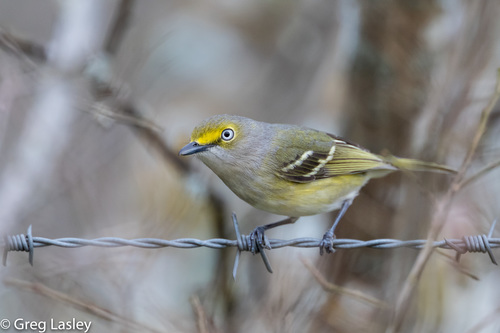
White-eyed Vireo
The White-eyed Vireo (Vireo griseus) is a small, active songbird found primarily in the southeastern United States. Known for its distinctive white iris and bold wing bars, this vireo plays an important role in its ecosystem by controlling insect populations. It is a bird of thickets and shrubby habitats, often heard before it is seen, with a characteristic, snappy song that varies regionally. While not globally threatened, its populations are affected by habitat loss and fragmentation.
11-13 cm
Length
18-20 cm
Wingspan
Least Concern
Conservation Status
Distribution
Primarily the southeastern United States, ranging from southern New Jersey west to central Texas, and south to Florida and parts of eastern Mexico and Central America. Some populations migrate to the Caribbean and Central America for the winter.
Lifespan
Typically 3-5 years in the wild, but can be longer.
White-eyed Vireo's Habitat
Habitat Types
Dense thickets, Shrublands, Woodland edges, Overgrown fields
Climate Zones
Temperate, Subtropical
Adaptations
Their dense habitat preference provides protection from predators and ample nesting sites. The birds' relatively small size and agility allow them to maneuver through dense vegetation.
Variations
Several subspecies are recognized, differing slightly in plumage and size. For example, *Vireo griseus noveboracensis* is found in the northern part of the range, while *Vireo griseus maynardi* is found in the Florida Keys.
Appearance
Breeding Plumage
Similar throughout the year.
Seasonal Feather Changes
Little to none
Sex Based Plumage Differences
Males and females are visually similar.
Notable Features
Distinctive white iris, Yellow spectacles around the eyes, Two bold white wing bars, Olive-green upperparts, whitish underparts
Diet and Feeding
Primary Foods
Insects, Spiders, Small berries (especially in fall and winter)
Foraging Behavior
Forages actively in dense foliage, gleaning insects from leaves and branches. Often hangs upside down to inspect the undersides of leaves.
Specializations
Their relatively short, stout bill is well-suited for catching and consuming insects.
Seasonal Diet Variations
Primarily insectivorous during the breeding season. In fall and winter, they incorporate more berries and fruits into their diet.
Behavior
Social Structure
Generally solitary or in pairs during the breeding season. May form small flocks during migration and in winter.
Communication
Distinctive, snappy song, often described as "chick-a-per-wee-oo" or "quick, pick up the beer check", Various call notes, including scolding chatters and soft chips
Migration
Northern populations are migratory, spending winters in the southern US, Mexico, and Central America. Southern populations may be resident or short-distance migrants.
Territorial or Group Behaviors
Males are highly territorial during the breeding season, defending their nesting area from other males.
Conservation
Threats
Habitat loss and fragmentation due to development and agriculture, Nest parasitism by Brown-headed Cowbirds
Protection Programs
None specifically for White-eyed Vireos, but general habitat conservation efforts benefit the species.
Local National Laws
Protected under the Migratory Bird Treaty Act in the United States.
Population Trend
Generally stable, but some regional declines have been noted.
Population Estimates
Not Evaluated
Interesting Facts
White-eyed Vireos are known for their variable songs.
Different populations have distinct song variations, almost like regional dialects.
They often incorporate spider silk into their nests.
The silk helps to bind the nest materials together and provide structural support.
These birds are very active
They are constantly moving, hopping and flitting through branches looking for insects.
Faqs about White-eyed Vireo
What do White-eyed Vireos eat?
They primarily eat insects and spiders, but also consume small berries, especially in fall and winter.
Where do White-eyed Vireos live?
They prefer dense thickets, shrublands, and woodland edges, primarily in the southeastern United States.
Are White-eyed Vireos endangered?
No, they are currently listed as a species of Least Concern by the IUCN.
How can I attract White-eyed Vireos to my yard?
Planting native shrubs and trees that provide dense cover and food sources (insects and berries) can help attract them.
Copyright @ Nature Style Limited. All Rights Reserved.
 English
English